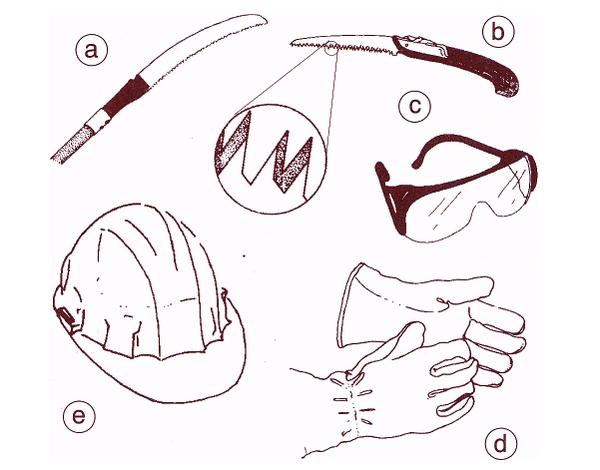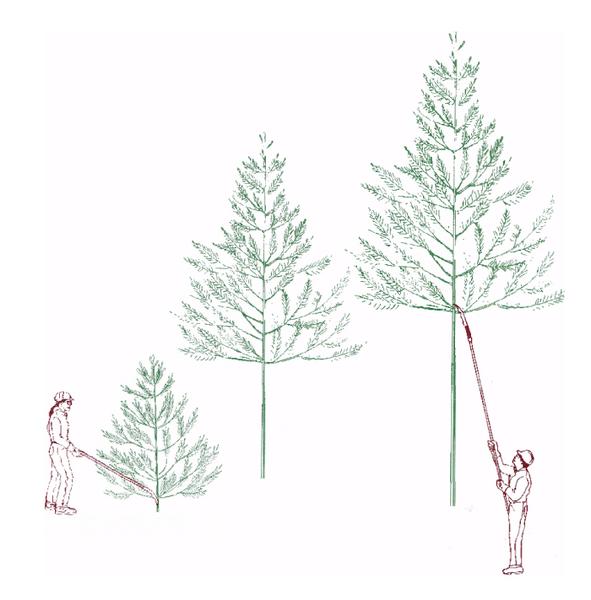Pruning woodland trees can improve timber value, appearance, access, and remove dead and diseased branchwood. Although branch shedding or self-pruning occurs naturally, landowners often have objectives that can be enhanced or expedited by artificial pruning. Pruning is the removal of live or dead branches from standing trees. Natural-target pruning is a proven technique for removing branches that avoids discolored or decaying wood associated with other pruning methods. This Woodland Owner Note describes when and how to natural-target prune young pines and hardwoods for timber production, appearance, and access.
Equipment
Successful pruning begins with sharp tools. A pole saw allows for efficient pruning up to and beyond the first merchantable log—about 18 feet. The teeth of pruning saws cut on the pull stroke, easily removing small limbs with ease. Pole saws come in sectional lengths of 4 to 8 feet. A 4-foot pole saw is efficient for removing lower branches as well as limbs up to 8 feet in height. Pistol-grip pruning saws are useful for removing limbs within arm's reach. Hand and pole pruners, loppers, chainsaws and carpenter's hand saws are inappropriate for this type of pruning. These often crush branchwood or leave jagged wounds that delay the closure of the cut. Always include eye, hand, and head protection as a part of your pruning equipment.
Choosing Crop Trees
The volume, quality, vigor, and value of woodland trees are enhanced through periodic thinnings, which concentrate growth onto the most merchantable, straightest, crop trees (Table 1). As tree spacing increases, branches persist longer and grow larger. Pruning, combined with thinning, can enhance the quality and value of your timber by concentrating knots into a small interior core of trunkwood. Since pruning can be one of the most expensive forest management practices, prune only those trees that will remain at final harvest (Table 1), not those to be removed during intermediate thinnings
| Trees / acre | Spacing Between Trees at Final Harvest | |
|---|---|---|
| Pine* | 100 - 120 | 19 - 21 feet |
| Hardwood** | 60 - 80 | 23 - 27 feet |
| * white, loblolly, longleaf ** red and white oak, yellow poplar, ash, walnut |
||
Start Early
Prune branches before they reach 11⁄2 inches in diameter to enhance wound closure and minimize knot size. Restrict pruning to the height of the first full log (17 feet), since the bottom log of a tree can contain as much as one-third to over one-half of the tree's merchantable volume.
Prune early and frequently for best results. Prune in stages, removing only a few branches during each lift (Figure 2).
How Much to Prune
Woodland pruning is a compromise of limiting cost, increasing timber value, and decreasing growth potential. Tree growth is directly related to the amount of leaf or needle area on the tree. Excessive pruning can affect tree growth significantly, decreasing growth by as much as one-half! Therefore, to maintain tree vigor, do not remove too much of the crown (portion of tree in leaves) during any one lift. In young trees, maintain two-thirds of the tree height with live branches. As trees develop, the portion in live crown can be decreased to one-half of the height of the tree (Figure 3).
The Kindest Cuts
Proper pruning leads to the greatest benefits. Natural-target pruning involves a cut immediately outside the branch collar, a swollen area at the base of the branch (Figure 4). Cutting outside the branch collar does not disturb trunkwood, minimizing discoloration, decay, or other wood defects in the core of the tree. As the old adage states, "routine pruning can be done anytime the saw is sharp." Dormant season— when weather and working conditions are comfortable—is best for timber stand improvement pruning. Avoid pruning during leaf-out when tree energy reserves are lowest. Also, avoid pruning until leaf-fall is complete—that’s when trees have recovered vital compounds from the foliage.
When Does Pruning Pay?
Tree growth and subsequent closure of pruning wounds will vary greatly by site, stand age, species, genetics, and extent of pruning. To maximize the returns from pruning, prune while the stem is 4 to 6 inches in diameter at the point of branch removal. Thin as needed to maintain vigorous growth on pruned crop trees. Remember, pruning is a long-term proposition and returns may take decades to materialize.
Profitable pruning assumes that costs will be offset by an increased stumpage value at harvest. Clear, defect-free logs have historically brought a higher stumpage price. Pruning can increase the percentage of clear wood in the first log, enabling a landowner to market more stumpage as higher value plywood, grade, and veneer logs. Depending upon local market conditions, competition among buyers, and future demand, pruning is most apt to be profitable for landowners who keep costs low and focus solely on crop trees and only on their best sites. Documenting the extent and cost of pruning may also help reduce future tax liability because pruning costs may be deducted as a business expense or capitalized and added to the timber basis.
Special Purpose Pruning
Beauty and Appearance
- Concentrate pruning on trees in areas where you wish to maximize visual impact.
- Prune the terminal leader to create tree shapes of your choosing. Pruning can be more or less severe as objectives dictate.
- Crown raising (removing lower branches) can provide clearance for access and expose scenic vistas.
Wildlife
- Cut through the branch collar of large branches (Figure 4, Line AX) or forks to induce decay and cavity formation on a few misshapen trees per acre.
- Concentrate future cavity trees along creek bottoms or in mast (acorn and nut) producing areas, not along trails or near recreational access.
- Prune mast trees to maintain production at a height more accessible to wildlife.
- Use removed branches to construct brush piles near field and forest edges or to provide fish cover and structure in farm ponds.
Publication date: Sept. 18, 2019
Reviewed/Revised: July 24, 2024
WON-34
N.C. Cooperative Extension prohibits discrimination and harassment regardless of age, color, disability, family and marital status, gender identity, national origin, political beliefs, race, religion, sex (including pregnancy), sexual orientation and veteran status.




